

Distances from the Sun. We're 99% certain this is the most beautiful footage of Earth's auroras yet recorded. Explore the planet Mars with realistic Mars habitats, rockets, ground cars and robots. Orbital Sciences : l'espace public devient de plus en plus privé. Pour mettre un satellite en orbite ou envoyer une capsule ravitailler la Station spatiale internationale, il n'y a plus besoin que des gouvernements forts demandent un effort national.
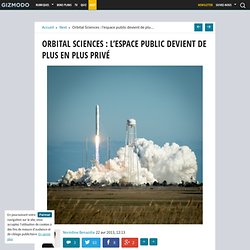
Il suffit simplement de décrocher son téléphone et de demander à des sociétés privées si elles ont un vol libre dans les 10 prochaines années. Aujourd'hui, Orbital Sciences Corp vient de réussir son premier vol d'essai en envoyant sa fusée Antares embarquant 3,8 tonnes de charge en orbite autour de la Terre. Orbital Sciences est une des 2 sociétés (l’autre s’appelle SpaceX) à avoir décroché un contrat avec la NASA pour ravitailler la Station spatiale internationale tant que les États-Unis n’ont pas de navette ou de capsule exploitable. Ce soir, Orbital Sciences a réussi à placer en orbite une fausse capsule Cygnus pour le lancement d’essai de leur fusée Antares.
Le vol d’essai de la fusée Antares était initialement prévu, il y a plus d’un an. Photo : NASA/Bill Ingalls. How It Works: NASA’s Curiosity Mars Rover. Lexique d'astronomie. Kepler’s Tally of Planets - Interactive Feature. Le moteur 3D de vos rêves. Le moteur 3D de vos rêves On va commencer la journée avec un peu de poésie dans ce monde de brute.

Et cette fois, la poésie, c'est un moteur de jeu qui nous l'apporte. Le moteur Outerra propose tout simplement de créer des planètes entières et de s'y balader de l'espace jusqu'au plancher des vaches sans temps de chargement ou décors (murs) artificiels. De la vraie 3D sans limites... Imaginez un MMO Minecraft-Like avec une couche d'espace intergalactique sur ce genre d'environnement.
Les petits gars qui développent cette techno sont capables, une fois la planète modélisée, d'y mettre des routes, des véhicules, ou tous types d'objets 3D qui respectera les lois de la physique en vigueur sur la planète. D'autres images et vidéos sont visibles ici. Comment capturer un astéroïde ? Comment capturer un astéroïde ?

Le budget 2014 de la NASA est voté et la mission de capture et de remorquage d'un astéroïde à des fins d'études fait partie de ce budget. Excellente nouvelle ! En apprenant à capturer des astéroïdes, nous pourrons en apprendre plus sur ces corps rocheux et exploiter leurs ressources minières. Kickstarting a Space Telescope?! Hubble's Most Mind Expanding Photos of the Universe.
The just-turned-21 Hubble Space Telescope has spent its entire life taking photographs of such enormous, otherworldly things that words stop working.

And the events in its photographs happened so long ago, notions of time stop working too. But don’t speak, and forget about the time. Here, in no particular order, are nine pretty big reminders that you are tiny, insignificant, and yet part of an awesome network of particles and forces that we’re only beginning to understand. Good thing we’ve had you Hubble, to help us think about this—and, of course, spruce up our computer desktop backgrounds.
Frank Tinsley, art of ... : un album sur Flickr. Kepler mission discovers first planet orbiting two stars. Artist's concept illustrating Kepler-16b, the first planet known to definitively orbit two stars (Image: NASA/JPL-Caltech/T.
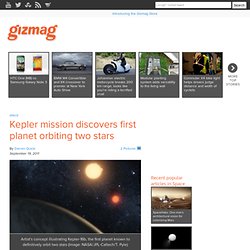
Pyle) Image Gallery (2 images) Powerful winds on giant planets confined to a thin atmospheric layer. The icy giant worlds Uranus and Neptune are the least studied planets in the Solar System.
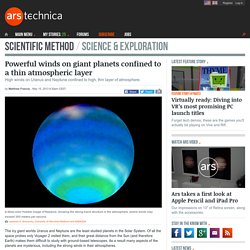
Of all the space probes only Voyager 2 visited them, and their great distance from the Sun (and therefore Earth) makes them difficult to study with ground-based telescopes. As a result many aspects of the planets are mysterious, including the strong winds in their atmospheres. A new study of data from Voyager 2 and the Hubble Space Telescope may have demonstrated that the weather on Uranus and Neptune is confined to a relatively thin layer of atmosphere. 10 cool NASA projects for studying the environment.
Commercial Crew Program. SNC's Dream Chaser test flight craft arrived at NASA Dryden to begin tests of its flight and runway landing systems while NASA astronauts will be at Langley to fly simulations of a Dream Chaser ...
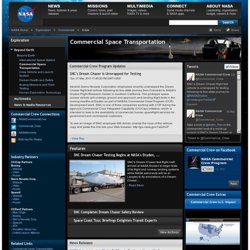
Sierra Nevada Corp. (SNC) Space Systems of Louisville, Colo., completed its first major, comprehensive safety review of its Dream Chaser Space System. Federal and state transportation experts tour Kennedy Space Center and Cape Canaveral Air Force Station to learn about new spaceport activities. The Planetary Society. Welcome! — PyEphem home page. We Are Floating In Space: Spacewalk. By Craig Pearson on May 10th, 2013 at 4:00 pm.

My application to be an astronaut was turned down because it was written in crayon, and now that I read it back in the cold light of day I notice it appeared pretty threatening. Sorry, NASA! My aluminum hat must have slipped and enabled an alien to take control of my writing arm. If, like me, you’ve been rejected for astronauthood on petty and unfounded claims of bad penmanship and terrorist activity, then there’s another route. All you need is Spacewalk, and an Oculus Rift. There’s a multiplayer option as well, and although I’ve not found anyone online to join me in my EVA, I had it running on my LAN. Oh and don’t go looking for your Gtalk window. Des communications spatiales LASER. Augmenter les vitesses de transfert de données est un doux rêve auquel nous aspirons tous.
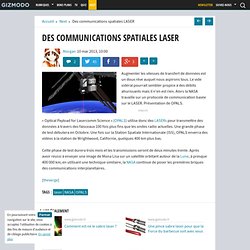
Le vide sidéral pourrait sembler propice à des débits ahurissants mais il n'en est rien. A new detector has a clever way of detecting dark matter. A new dark matter detector has gone online today, using a rather clever method of searching for signs of rare interactions between dark and regular matter.
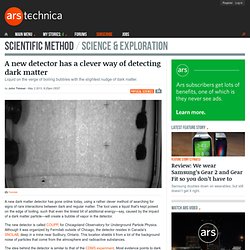
The tool uses a liquid that's kept poised on the edge of boiling, such that even the tiniest bit of additional energy—say, caused by the impact of a dark matter particle—will create a bubble of vapor in the detector. The new detector is called COUPP, for Chicagoland Observatory for Underground Particle Physics. Although it was organized by Fermilab outside of Chicago, the detector resides in Canada's SNOLAB, deep in a mine near Sudbury, Ontario. Un océan de lave à la surface de Mercure. Si les yeux du monde semblent tournés vers Mars, la Planète Rouge n'est pas seule dans notre système solaire.
Des scientifiques du Massachusetts Institute of Technology se sont penchés sur Mercure et ont découvert qu'un océan de lave avait coulé à sa surface il y a quatre milliards d'années. C’est en analysant des données de la sonde Messenger Probe de la NASA que des scientifiques du MIT se sont rendus compte, avec étonnement, de la présence de deux types de roche complètement différents. Telescope detects the most energetic gamma-ray burst yet. Gamma-ray bursts, the explosions of extremely massive stars, are some of the most violent phenomena in the Universe. Early in the morning of April 27, 2013, an exceptionally bright gamma-ray burst (GRB) triggered the automatic detection system aboard the orbiting Fermi Gamma Ray Telescope. The system located the explosion within the constellation Leo.
Curiosity : mission accomplie ! Mars a pu héberger la vie ! C’est un jour historique ! DE-STAR, le destructeur d'astéroïdes. Ces dernières années, notre belle planète bleue a frôlé l'accident de près plus d'une fois. Et la menace est bien réelle ! Il suffirait d'un seul de ces gros cailloux, d'une trajectoire un peu trop proche et c'en est fini de nous ! Il nous donc faut une solution pour s'en débarrasser. DE-STAR pourrait nous sauver la vie ! High-mass pulsar binary provides best test of general relativity. The general theory of relativity is a remarkably successful model for gravity. However, many of the best tests for it don't push its limits: they measure phenomena where gravity is relatively weak. Some alternative theories predict different behavior in areas subject to very strong gravity, like near the surface of a pulsar—the compact, rapidly rotating remnant of a massive star (also called a neutron star).
For that reason, astronomers are very interested in finding a pulsar paired with another high-mass object. One such system has now provided an especially sensitive test of strong gravity. How To Clean Up Space Junk. How To Clean Up Space Junk. Iron in Egyptian relics came from space. Mysterious radio bursts come from outside our galaxy. Astronomers using a radiotelescope to perform a survey of a broad patch of the sky have spotted a set of unusual events that last for just a handful of milliseconds. The events don't repeat and aren't accompanied by anything obvious at optical or X-ray wavelengths. A careful examination of their properties, however, gives reason to believe that they are likely to occur at great distances from our galaxy, suggesting they are the product of cataclysmic occurrences.
Based on the four events detected during their survey of a single patch of the sky, the astronomers suggest that thousands of them may be visible from Earth each day—provided we know where to look. There's really not a lot to say about the Fast Radio Bursts (FRBs) themselves. Planétarium. A Space Journey. Sky Map - Astronomy App for Android. Cassini captures gigantic hurricane on Saturn in exquisite detail. Jupiter's Great Red Spot may get most of the attention, but it's hardly the only big weather event in the Solar System. Saturn, for example, has an odd hexagonal pattern in the clouds at its north pole, and when the planet tilted enough to illuminate it, the light revealed a giant hurricane embedded in the center of the hexagon. Scientists think the immense storm may have been there for years.
But Saturn is also home to transient storms that show up sporadically. The most notable of these are the Great White Spots, which can persist for months and alter the weather on a planetary scale. Great White Spots are rare, with only six having been observed since 1876. The storm turned out to be very violent, with convective features as big as 3,000 km across that could form and dissipate in as little as 10 hours. Scale. Laser propulsion. Laser propulsion is a form of beam-powered propulsion where the energy source is a remote (usually ground-based) laser system and separate from the reaction mass. This form of propulsion differs from a conventional chemical rocket where both energy and reaction mass come from the solid or liquid propellants carried on board the vehicle. A laser launch Heat Exchanger Thruster system History[edit] The basic concepts underlying laser propulsion were first developed by Eugene Sanger and the Hungarian physicist Georgii Marx, with practical schemes being developed by Arthur Kantrowitz and Wolfgang Moekel in the 1970s.[1] Laser propulsion systems may transfer momentum to a spacecraft in two different ways.
The James Webb Space Telescope. Galerie de FEI Company. More meteors? Interstellar gas allows chemical reactions caused by quantum tunneling. In recent years, astronomers have detected some simple organic chemicals in the disks of material surrounding some stars. In our own Solar System, these seem to have undergone reactions that converted them into more complex molecules—some of them crucial for life—that have been found on meteorites. Astronomy for Astrologers, Part 1. Earth Live. Planétarium - Carte des étoiles interactive et ciel virtuel. Galaxy Zoo. Carl Boudreau – Astrology For Everyone – The Astrology Of July 2013, Approximately – Qauntum Leap – 28 June 2013.
Découverte de trois exoplanètes potentiellement habitables. Des astronomes de l'Observatoire européen austral (ESO) ont découvert dans la constellation du Scorpion un système solaire "doté d'une zone habitable bien remplie", avec trois "super-Terres" où les conditions seraient compatibles avec l'existence d'eau liquide. C'est autour de l'étoile Gliese 667C, d'une masse équivalente à un tiers de celle de notre Soleil, que l'équipe a fait cette trouvaille, à l'aide de l'instrument HARPS équipant le télescope de 3,6 mètres de l'ESO au Chili, indique l'organisation dans un communiqué.
Le système de trois étoiles auquel appartient Gliese 667C est abondamment étudié par les scientifiques. Non seulement il est dans le voisinage immédiat de notre système solaire (22 années-lumière) mais il est aussi étonnamment similaire. Il représente donc un candidat de choix pour la recherche d'exoplanètes potentiellement habitables. Au total, les astronomes ont donc identifié au moins cinq planètes, deux autres demandant encore à être confirmées. Last transmitter dies, finalizing retirement for ocean-sensing satellite. Wildfires Smoke Crosses the Atlantic. Ce trou noir tourne (presque) à la vitesse de la lumière. Trs-new.jpl.nasa.gov/dspace/bitstream/2014/13644/1/00-0010.pdf. BRITE, le télescope spatial le plus petit au monde. Gearing up to search for gravity waves. Voyager. Voici comment la NASA va capturer un astéroïde. Creating a Hubble Galaxy in Two Minutes. Orson Welles: Who's Out There? (NASA, 1975) Costs of US piloted programs.
La NASA étudie les portails magnétiques. Www.nasa.gov/pdf/703154main_earth_art-ebook.pdf. Saving Fermi: NASA’s system for avoiding collisions with space junk. Remains of a supernova fall to Earth. Mars Science Laboratory: Time Lapse - Sol 0 - Sol 281. SDO_Earth_scale-EDIT2.jpg (Image JPEG, 975x1000 pixels) - Redimensionnée (62%) Does the Big Bang necessarily mean we’re part of a multiverse? Everybody Poops : Atomic Toasters. How Kepler’s Pointing System Might Have Failed. 15 Mind-Blowing Featured Images by NASA. Kepler spots two super Earths, one squarely in the habitable zone. Willamette Meteorite.